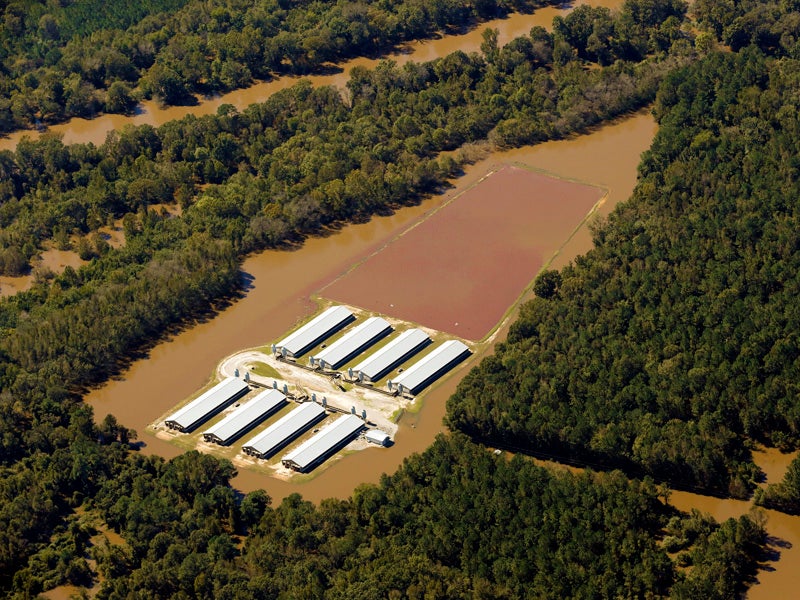Toxic Emissions from Factory Farms No Longer a Secret
The D.C. circuit court agreed with Earthjustice that the government and the public have a right to know about toxic emissions from industrial animal facilities.

This page was published 7 years ago. Find the latest on Earthjustice’s work.
As they say, sunlight is the best disinfectant. Thanks to a decision yesterday from the U.S. Court of Appeals for the D.C. Circuit, the government and the public will once again have access to information about potentially deadly air pollution from industrial animal facilities. As I explained in a blog post back in December, for more than eight years the EPA has exempted these massive livestock facilities from the pollution reporting law that normally applies to all polluting facilities.
Because of yesterday’s ruling, the government and the public will again know about releases of hazardous substances like ammonia that can affect our health and safety. Government agencies can use this data to better protect the public from toxic emissions and respond to emergencies. And the public can use these reports to avoid health threats in their communities from livestock pollution.
Because of yesterday’s ruling, the government and the public will again know about releases of hazardous substances like ammonia that can affect our health and safety.
Industrial animal facilities, better known as factory farms, emit enormous amounts of pollution. Most comes from animal waste. As the court explained in its ruling, “anyone with a pet knows firsthand that raising animals means dealing with animal waste. But many of us may not realize that as the waste breaks down, it emits serious pollutants—most notably ammonia and hydrogen sulfide. While those emissions are miniscule for pet owners, they can be quite substantial for farms that have hundreds or thousands of animals.”
An average dairy cow, for example, produces well over 100 pounds of manure a day—more than 200 times what an average human produces. A facility with hundreds or thousands of cows can produce the same amount of waste as an entire town, or even a large city.
Unlike human sewage, which is treated at wastewater plants to create a non-polluting discharge, these animal facilities usually store their untreated waste in huge open pits. The waste is then sprayed into the air and onto fields in massive quantities—much more than is needed to fertilize the fields. This leads to substantial toxic air pollution from both the pits and the fields. The EPA itself estimates that nearly three quarters of the country’s ammonia pollution comes from these livestock facilities.
The EPA itself estimates that nearly three quarters of the country’s ammonia pollution comes from these livestock facilities.
And these substantial emissions can lead to serious health problems, including chronic lung ailments or worse. As the court noted, the “risk isn’t just theoretical; people have become seriously ill and even died” from emissions from these facilities. Instead of trying to solve this potentially lethal problem, the EPA chose to pretend that it doesn’t exist.
In exempting factory farms from the simple reporting requirements that apply to other polluters, the EPA ignored the comments of state and local clean air and emergency response agencies. These agencies said that emissions data are vital; the information allows them to do their jobs. The EPA also disregarded comments from people across the country who live near industrial animal facilities and have both a desperate need and a right to know about the toxics they’re being exposed to. And, most importantly for the court, the EPA ignored the mandate of the country’s pollution reporting law, which was passed by Congress.
The D.C. circuit court ruled that the EPA can no longer ignore Congress’s clear directive. The court found that the “sweeping reporting mandate” of the law clearly covers animal facilities, so the EPA’s exemption for these facilities was illegal. The court also recognized that there are “real benefits” to pollution reporting, and that there are practical measures, like changes in waste management systems, that these animal facilities can take to reduce their emissions.
We can all breathe a little easier because the court ruled in favor of public health by once again mandating that livestock facilities report their toxic emissions. Or, at least, now we’ll know why we haven’t been able to breathe easy for the past eight years.
About this series
Fertile Grounds is a blog series that examines the challenges and opportunities in ensuring access to healthy, sustainable and affordable food for all. We talk about the entire lifecycle of food—from seed selection and planting to consumption and disposal—because there is potential for improvement throughout. We’re informed by the expertise of our many clients and allies and by Earthjustice’s years of work to ban harmful pesticides, encourage sustainable farming methods, reduce pollution, support farmworker justice and promote a healthy relationship between farmers and communities.
Based in our Northeast office, Jonathan is a senior attorney with the Community Partnerships Program.
Established in 2008, Earthjustice’s Northeast Office, located in New York City, is at the forefront of issues at the intersection of energy, environmental health, and social justice.
Earthjustice’s Sustainable Food and Farming program aims to make our nation’s food system safer and more climate friendly.
